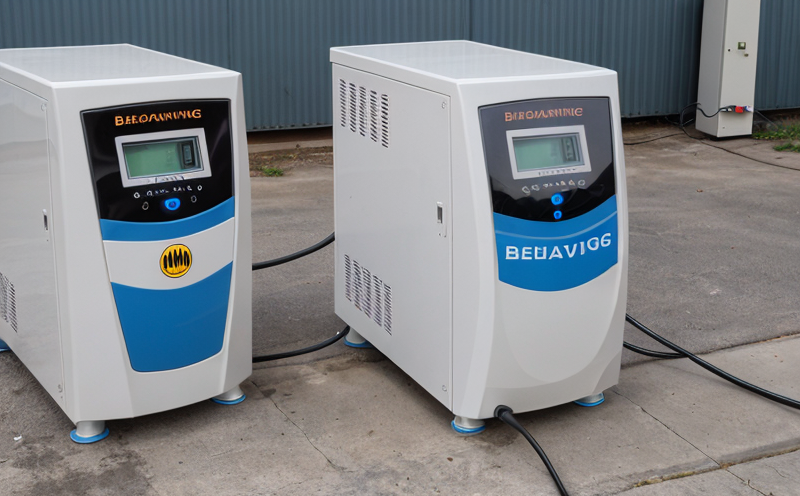GB/T 32620 Charging and Discharging Testing of Lithium Batteries in Consumer Applications
The GB/T 32620 standard is a crucial document that outlines the testing procedures for the charging and discharging behavior of lithium batteries used in consumer applications. This standard ensures product safety, reliability, and performance by providing detailed guidelines on how to conduct these tests accurately and consistently.
Lithium batteries are widely employed across various consumer electronics products such as smartphones, tablets, laptops, and electric vehicles (EVs). The charging and discharging behavior of these batteries is critical for their longevity and safety. GB/T 32620 provides specific test methods to evaluate the performance under different conditions, helping manufacturers ensure that their products meet stringent quality standards.
The standard covers a range of tests including charge rate verification, discharge capacity measurement, internal resistance determination, and more. These tests help identify any potential issues early in the product lifecycle, allowing for necessary adjustments before mass production begins. By adhering to GB/T 32620, manufacturers can maintain compliance with local regulations while also enhancing their products' overall quality.
Compliance with this standard is particularly important for companies operating within China or those looking to export goods into the Chinese market. However, its principles and practices are valuable globally as they contribute significantly to ensuring consistent battery performance across diverse environments and applications.
To perform these tests effectively, laboratories must be equipped with specialized equipment such as programmable power supplies, precision scales, data logging systems, etc., which can accurately measure voltage, current, temperature changes during charging and discharging cycles. Additionally, safety precautions are essential when dealing with high-voltage batteries; proper ventilation, fire suppression systems, and personal protective gear should always be in place.
The process typically involves setting up the battery in a controlled environment according to specified parameters outlined by GB/T 32620. The charging cycle begins at a specific voltage level while monitoring various factors like temperature rise or fall rates throughout each stage of the procedure. After reaching full charge, the battery undergoes several discharge cycles until it reaches predetermined thresholds. Throughout this process, detailed records are kept on all relevant data points for analysis.
Testing according to GB/T 32620 not only helps manufacturers improve their products' reliability but also contributes positively towards sustainability goals by minimizing waste through better design practices based on accurate test results. Furthermore, it supports safer usage scenarios which enhance consumer confidence in purchasing such devices knowing that they have undergone rigorous quality checks.
For quality managers and R&D engineers working with lithium batteries or related technologies, understanding the requirements of GB/T 32620 is invaluable. This knowledge ensures that products meet industry standards, providing peace of mind for both manufacturers and end-users alike.
Why It Matters
The importance of properly testing lithium batteries cannot be overstated in today’s tech-driven world where portable power sources play an integral role. Properly tested batteries ensure extended lifespan, improved safety measures, enhanced performance, reduced environmental impact, and increased user satisfaction.
- Extended Lifespan: Through precise testing, potential weaknesses within the battery can be identified early on allowing for corrective actions to be taken before mass production begins. This leads to longer-lasting products that consumers appreciate.
- Better Safety Measures: Accurate tests help manufacturers identify any hazardous conditions that could arise during usage scenarios like overcharging or overheating. By addressing these issues proactively, risks are minimized, protecting both users and the environment.
- Enhanced Performance: Testing ensures optimal performance across different operating conditions ensuring consistent output regardless of external factors such as temperature fluctuations or altitude changes.
- Reduced Environmental Impact: More efficient batteries mean less frequent replacements leading to reduced electronic waste. Improved design based on accurate test results translates into greener manufacturing processes too.
- Increased User Satisfaction: Reliable and safe products build trust between manufacturers and their customers fostering brand loyalty.
These benefits extend beyond just consumer electronics; they apply equally to other sectors where lithium batteries are used, including automotive manufacturing and renewable energy storage systems. Proper testing ensures consistent quality across all applications, contributing significantly towards meeting global sustainability goals.
International Acceptance and Recognition
The GB/T 32620 standard has gained significant recognition internationally due to its rigorous approach towards ensuring product safety and reliability. Many countries recognize this standard as an authoritative source for evaluating lithium batteries, particularly those used in consumer applications.
Incorporating elements from international standards such as ISO/IEC, ASTM, and EN, GB/T 32620 provides a harmonized framework that facilitates easier trade between nations while maintaining high quality expectations. Its acceptance by major manufacturers worldwide ensures consistency across borders, reducing discrepancies in testing methodologies.
For companies operating globally or looking to expand their reach into international markets, compliance with this standard is not only advantageous but often mandatory. It demonstrates a commitment to producing safe and reliable products that meet global standards, thereby enhancing brand reputation and customer trust.
The widespread adoption of GB/T 32620 also fosters collaboration among industry stakeholders promoting best practices in battery technology development. This collaborative effort helps drive innovation while ensuring consumer protection through stringent quality controls.
Environmental and Sustainability Contributions
- Reduced Electronic Waste: By identifying potential weaknesses early in the lifecycle, manufacturers can take corrective actions before mass production begins. This leads to longer-lasting products that consumers appreciate.
- Increased Efficiency: Testing ensures optimal performance across different operating conditions ensuring consistent output regardless of external factors such as temperature fluctuations or altitude changes.
- Enhanced Safety: Proper testing helps manufacturers identify any hazardous conditions that could arise during usage scenarios like overcharging or overheating. By addressing these issues proactively, risks are minimized protecting both users and the environment.
The implementation of GB/T 32620 contributes positively towards sustainability goals by minimizing waste through better design practices based on accurate test results. It supports safer usage scenarios which enhance consumer confidence in purchasing such devices knowing that they have undergone rigorous quality checks.





